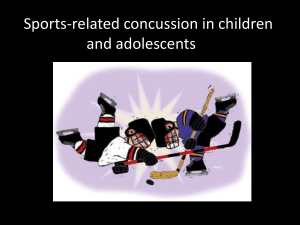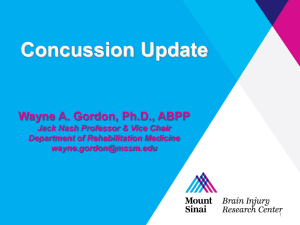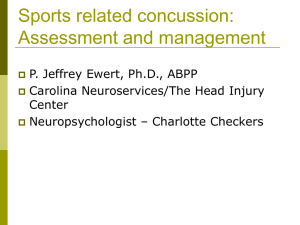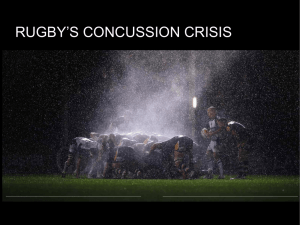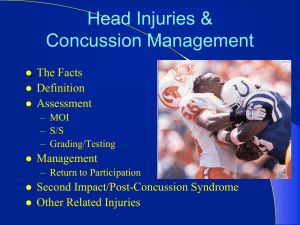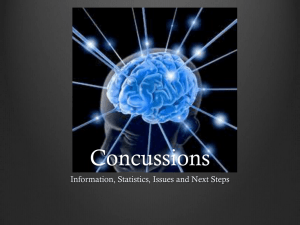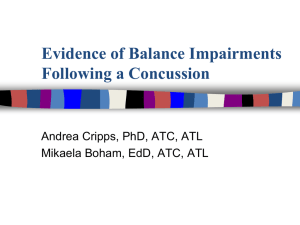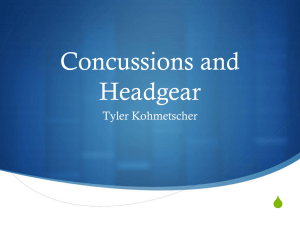CONCUSSION - Auckland Rugby Referees Association
advertisement
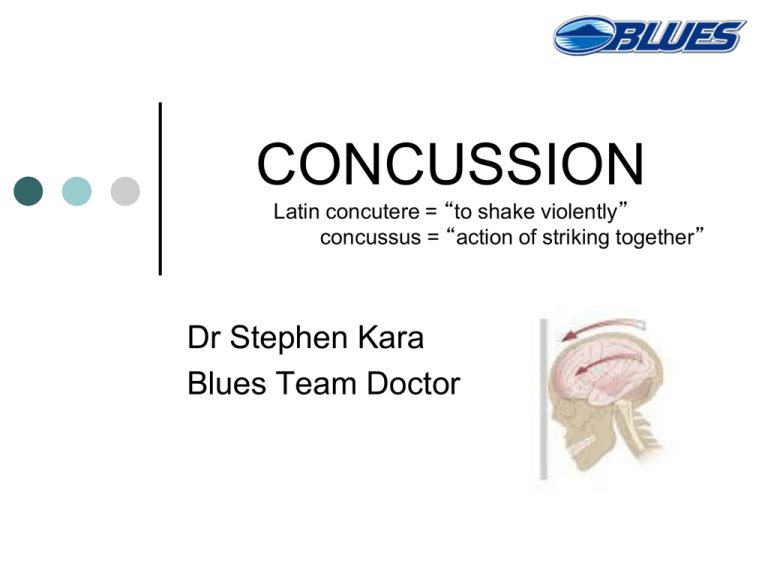
CONCUSSION Latin concutere = “to shake violently” concussus = “action of striking together” Dr Stephen Kara Blues Team Doctor Definition Consensus Statement of Concussion in Sport, Zurich 2008 Concussion is defined as a complex pathophysiological process affecting the brain, induced by traumatic biomechanical forces. Several common features that incorporate clinical, pathologic and biomechanical injury constructs that may be utilized in defining the nature of a concussive head injury include: 1. Concussion may be caused either by a direct blow to the head, face, neck or elsewhere on the body with an ‘‘impulsive’’ force transmitted to the head. 2. Concussion typically results in the rapid onset of short-lived impairment of neurological function that resolves spontaneously. 3. Concussion may result in neuropathological changes but the acute clinical symptoms largely reflect a functional disturbance rather than a structural injury. 4. Concussion results in a graded set of clinical symptoms that may or may not involve loss of consciousness. Resolution of the clinical and cognitive symptoms typically follows a sequential course; however it is important to note that in a small percentage of cases however, postconcussive symptoms may be prolonged. 5. No abnormality on standard structural neuro-imaging studies is seen in concussion. Definition Consensus Statement of Concussion Most Parents, Auckland 2012 Concussion is a brain injury from a blow to the head causing me or my child to have a loss of consciousness Concussion can cause me or my child to have a lot of brain symptoms especially headaches and sleep problems Concussion can cause me or my child to have lasting effects Tests need to be done to make sure me or my child does not have brain damage Definition Consensus Statement of Concussion Simplified Concussion is a traumatic brain injury causing an alteration in function producing a wide range of symptoms that generally get better by themselves over a 10 day period Do not have to have LOC Imaging investigations generally are not indicated Important Concussion Facts 1. 80-90% of concussions resolve over 7 – 10 days 2. Symptoms of concussion may take several hours to appear and may not be evident at the time of the injury 3. Symptoms can be varied from: physical (headache, nausea, vomiting, dizziness, poor balance) emotional (sad, depressed, irritable) cognitive (poor memory, confusion, poor concentration) sleep disturbance (more, less, difficult to go to sleep) 4. Debate over genetic markers and sports concussion 5. Recurrent concussion (defined as 3 or more): increased risk of lifetime depression 3 x increase risk of mild memory impairment in the future 5 x increase risk of mild cognitive impairment in the future - Rugby Facts in Concussion 1. 14% of all rugby players will sustain a concussion in a season (Hollis et al. 2011 BJSM) 2. Concussion is the 3rd highest match-related injury 3. Lower levels of competition lower risk 4. Tackles and collisions are the events most likely associated with a concussion 5. Midfield backs at higher risk Chris Lowrey this year Canes Is This a Concussion? Brumbies guy who stumbles around On Field Management Consensus Statement of Concussion in Sport, Zurich 2008 2.2b The appropriate disposition of the player must be determined by the treating healthcare provider in a timely manner. If no healthcare provider is available, the player should be safely removed from practice or play and urgent referral to a physician arranged. 2.2e A player with diagnosed concussion should not be allowed to return to play on the day of injury. Occasionally in adult athletes, there may be return to play on the same day as the injury. See Section 4.2. On Field Management Practical Advice 2012 1. 2. 3. 4. You are the ref and have the power to remove any player from the field if you feel the player is not medically safe to continue Maddock’s Questions – standard orientation questions (time, place, person) have been shown to be unreliable LOC = concussed General look and behaviour of the player (eyes, movement, speech) Maddock’s Questions Which field are we at? Which team are we playing today? Who is your opponent at present? Which half are we in? How far into the half is it? Which side scored the last points / try? Which team did we play last week? Did we win last week? Management of Concussion Age <18yrs: mandatory 3 week stand-down (age is a concussion modifier as the adolescent, young brain heals slower) Medical Clearance prior to return to training Use of ACC Funded Concussion Clinics if medical clearance is not able to be attained easily or prolonged symptoms What Happens at the Professional Level? SCAT II Testing Protocol Symptom score testing Cognitive testing – orientation, immediate memory, concentration, delayed recall Balance examination Coordination exam Physical examination – BP, neurological examination, cervical spine, maxillo-facial Computerized cognitive testing – CogSport or ImPact Once player has passed all of the above then proceed on Return to Play Protocol under guidance Graduated Return to Play Protocol Consensus Statement of Concussion in Sport, Zurich 2008 Rehabilitation stage Functional exercise at each stage of rehabilitation Objective of each stage 1. No activity Complete physical and cognitive rest Recovery 2. Light aerobic exercise Walking, swimming or stationary cycling keeping intensity <70% maximum predicted heart rate. No resistance training Increase heart rate 3. Sport-specific exercise Skating drills in ice hockey, running drills in soccer. No head impact activities Add movement 4. Non-contact training drills Progression to more complex training drills, eg. passing drills in football and ice hockey May start progressive resistance training) Exercise, coordination, and cognitive load 5. Full contact practice Following medical clearance participate in normal training activities Restore confidence and assess functional skills by coaching staff 6. Return to play Normal game play Thanks for Listening

